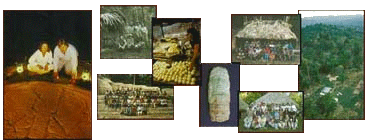
Directed by Arlen and Diane Chase of the University of Central Florida, the Caracol Archaeological Project investigations began with a series of preliminary trips into the site during 1983 and 1984. Fieldwork has been undertaken on a yearly basis since the first full field season in 1985. Caracol Archaeological Project investigations have been both long-term and large-scale. Over the course of the project, work has been undertaken in the site epicenter and its surrounding core, on early and late remains, on elite architecture and vaccant terrain, as well as on epigraphic history and subsistence systems. Research has focused on both survey and excavations. Excavations have included areal clearing, test excavations, trenches, and salvage operations in looted areas. Investigations have taken place in monumental architecture, in humble housemounds, and in agricultural fields. Digging has revealed the buildings that are currently visible at the site and more deeply buried constructions as well as burials, caches, or on-floor debris that allow glimpses into life in the past. The combined Caracol Archaeological Project investigations have led to the understanding that we currently have of Caracol – as a key Maya site that was occupied continuously from at least 600 B.C. to almost A.D. 1100, but that maintained its largest and densest population during the Late Classic Period at approximately A.D. 650 when minimally 115,000 – and more likely 150,000 – people occupied the city. This research has also documented the importance that warfare played in ancient Maya society. Perhaps the most important discovery made by the project was Caracol Altar 21, which records the defeat of Tikal, Guatemala (R2b-Q3) in A.D. 562. Archaeological data from Caracol demonstrate that the city benefitted greatly from its successful warfare.